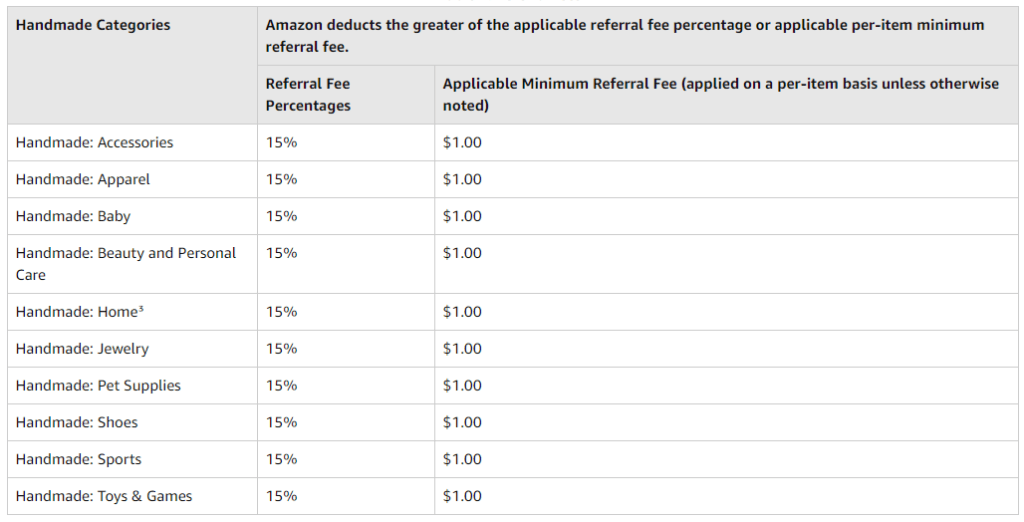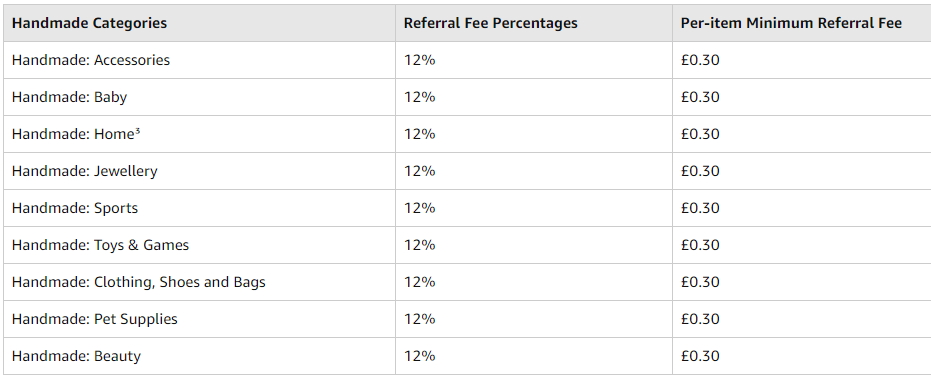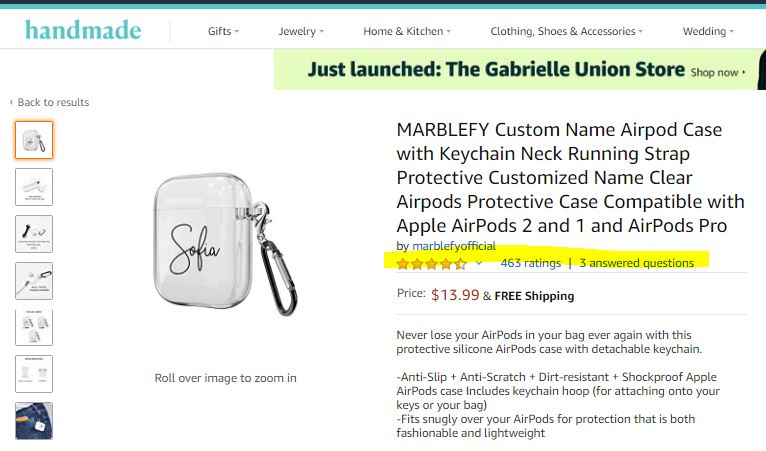![]()
Making a living as an artisan can be challenging if you’re still selling products through the traditional channel. If you haven’t noticed already, the internet is the new way forward and in today’s Amazon Handmade review, we’ll be exploring the opportunity, the pros, the cons, and other (better) alternatives to grow your creative business.
So, let’s get to know…
What Is Amazon Handmade

Amazon Handmade is equivalent to Etsy in the Amazon marketplace, yet little is known about the store despite its launch in 2015. Officially named Handmade at Amazon, the online store is a place where artists and craftsmen sell their handmade goods in the following categories;
- Accessories
- Apparel
- Baby
- Beauty and Personal Care
- Home and Design
- Jewelry
- Pet Supply
- Shoes
- Sports
- Toys and Games
Most small businesses are well aware of the Amazon platform, a place where you can input your details and set up a shop almost immediately. This, however, is not the case with the Handmade section.
Unlike other Amazon sellers, you need to be invited to sell, granted you abide by the strict criteria and your eligibility approved by the company. Amazon has included on its website the definition of handmade, a formality that needs to be met in order to sell on the marketplace.
Here’s a snippet of the details;
“All products available in your Amazon Handmade store must be handmade, i.e. created, altered or assembled entirely by hand (not from a kit). Products must be handmade by you (the artisan), by one of your employees (if your company has 20 or fewer employees), or a member of your business (if your business has less than 100 people). Sellers are unable to offer mass-produced products or products handmade by different artisans in the Amazon Handmade store”.
How to Sell on Amazon Handmade?
To begin the selling process on Handmade, you will need to fill out this form in order to set up an account. Once your application is approved, Amazon will email you their registration link where you will find all the information you need to set up a seller account.
Once your account is activated, you will then need to set up a seller profile. It is important to input as much information as you can in each section, including photos of your products. Your profile is what potential buyers will see first so make it look as professional as you can.
After all that is done, it is time to start listing items onto your online store. Amazon has made this process really easy through their step-by-step guide. You are also able to copy a listing once it has been advertised so that you can have a better organization of your products.
And that’s really all there is to it. Amazon does provide more extensive guides on its website, but overall, the process is pretty straightforward.
Is There Any Cost to Become a Handmade Seller?
It depends. To be an eligible handmade seller, you need to have a professional selling plan instead of an individual selling plan. The typical professional account on Amazon USA and Amazon UK costs $39.99 and £25 per month respectively.
If you do not sell more than 40 non-handmade products in categories other than Amazon Handmade in a given month, the monthly seller fee will be waived. But Amazon still takes a small commission through referral fees applied to each sale – that is 15% and 12% plus shipping fees for US sellers and UK sellers respectively.


The Advantages of Selling On Amazon Handmade
Selling on Amazon comes with many benefits, primarily due to the wide customer outreach. Regular shoppers may be interested to pick up a few handmade items during checkout. Plus, there’s an army of affiliates who can promote your products through the Amazon Associate program that pays 5% for the Handmade category.

Amazon customer feedback is a feature that can potentially boost marketability. If you have got unique products that people love, positive reviews and ratings are bound to draw a lot of attention and sales from new buyers. Also, if you’re eligible for the waiver, you can reduce the cost of business operations for the long term.
The Downsides of Selling on Amazon Handmade
Even though Amazon provides sellers with an online platform, it still lacks customization. Your store listing will still look like any other sellers and you can only include vital information – no personal or business website sharing is allowed because Amazon doesn’t want to drive sales away from its marketplace.
The other thing would be competition and this impact is going to be very obvious if your product isn’t unique enough or lack specific keywords in your product listing.
Say for example you’re selling handmade tote bags – there’s bound to be similar products from designer brands and other drop shippers. The last I check, there are more than 90K items in this category alone and given that many are still unaware of the Handmade section, it can be very tough for your products to be discovered if you’re just starting out.
Getting paid for a sale can be tedious on Amazon too. Based on rough calculations, it could take an average of 24 days to receive the payment from 1 transaction due to multiple phases processing the funds.
Lastly, in order to sell successfully on Amazon, you need to adhere to their rules and regulations. That includes abiding by the fee schedule (who knows how long the waiver is going to stay) and knowing what you can and can’t include in your online store. Going against their terms could cause your store to be shut down.
Amazon Handmade Vs Etsy
It is no surprise that while we’re on this topic, one will automatically think about Etsy as well. The creative marketplace has been a long-time favorite for craft sellers, establishing its online presence around 10 years before Handmade was launched. It also comes with an affiliate program that lets bloggers market your product for a small profit commission.
Customers who value handmade products with the intention of buying are likely to visit this site first so the chances of selling something unique are higher here. And they let you share your business website information too. The less cluttered user interface on-site also allows for better customer experience during product search and checkout.
Etsy’s interpretation of handmade is somewhat different from that of Amazon. Sellers can mass produce products within a factory as long as they include this information on their product listings.
Etsy’s fees are generally known to be less steep for sellers, charging $0.20 per item listing for 4 months with a 5% commission fee. When it comes to getting paid, funds are usually available to you immediately when a sale transaction is completed. This is easily reflected in your seller’s payment account.
Amazon Handmade Vs Your Own Online Store
When relying on another platform to sell your products, it’s obvious that you can’t control many budgeting and marketing aspects of your business. This has prompted many artisan sellers to increase their income streams by establishing their own online stores.
The advantages of selling independently through your own platform let you;
- Offer better customization to highlight your profession and business brand.
- Provide a proper channel of communication between you and your customers.
- Earn more profit without having to split sales commissions with other platforms.
- Able to sell as many products according to your business expansion.
- Grow your clientele through personalization and brand loyalty.
In the beginning, it’s good to try it out eCommerce platforms like Handmade and Etsy to get the experience of selling products online. But as soon as you get a good grasp of the basics, you should definitely consider setting a personal online store to generate a more sustainable income.
WordPress WooCommerce is a good place to start as it is optimized for search engines and easy to customize according to what you want. All you need is to get a domain name, create a WordPress site and install the free WooCommerce plugin which comes with the basic eCommerce features.
New to WordPress? No worries. Simply use the free builder tool below and take it for a test run.
Is Amazon Handmade Worth the Shot?
If you already have an individual selling plan, selling through Amazon Handmade is a convenient way of entering the artisan market without increasing the cost of investment. But be sure to prepare yourself for the high fees, the fierce competition and the lack of personal branding.
If you prefer to have a closer relationship with your customers and profiting from more sales, selling through Etsy and/or your own online store is the better way to go for the long run. At its fundamental, Etsy provides you with a more targeted audience, it complements the presence of your original site and doesn’t cut into your profit as much as Amazon does.
I hope this review has been useful so far. For more tips on how to grow a successful business through online marketing, take a free trial with my recommended training platform and if you’ve anything to share, let me know in the comment area below.

Hi Cathy, I am so glad I ran across this article! My daughter is 16 and one of her favorite things to do is make handmade jewelry. I was just explaining to her that she could sell jewelry online and see if it could turn into a small side business. She’s super excited and ready to take on this new adventure.
Seeing the pros and cons, I am sure it would be best that we set up a personal online store first and utilize the free WooCommerce plugin just like you mention in this article. This will give her plenty of space to experiment with eCommerce selling.
Great to hear your daughter doing something entrepreneurial at such a young age!
Thank you for putting together this awesome Amazon Handmade review for sellers. This article answered many of the questions I had before, but could not find the answer previously. Recently, my son came to me with a very unique idea of something he wanted to sell. I like the business idea, but suggested he should start a website first for people to reference the product before selling on any third party platform.
I’m glad to know you recommended that too.
Yes, it’s crucial to have an official product page for the things you’re planning to sell. That way, product and business information can be centralized and customers will have a reliable source to decide on their purchase.
I personally prefer starting your own store. There are many options these days in terms of website creation and you can easily build a professional-looking site at a relatively low cost than having to face such high fees from Amazon Handmade. It’s almost the equivalent of paying for a web hosting fee. Etsy is another good place to have a store but the level of competition is pretty high over there.
Your post is giving me a mixed feeling. Now, I do not know whether to go for Amazon Handmade or create a personal online store. I know Amazon can help me reach a wider audience but the fees are quite a lot for a new business owner. What do you think; sell on Etsy, Amazon Handmade, or through my own store?
Depends on what you’re selling, Riley. As long as you’re using a third-party platform, some kind of fees will incur. If you’re just starting to sell online, I would recommend selling on Etsy first. Once you get the hang of running an eCommerce store and building a list of customers, you can move your business to a personal store.
The fees for selling on Amazon Handmade is really high. I wasn’t expecting that. Etsy seems more doable so I’m probably going to try that. Do you know of other places for selling handmade products? Thanks.
Hi Jon. You can check my list here on places to sell handmade products online. Hope this helps.
Reading through your article has got me thinking more about selling through Amazon. Yes, you will have a big platform visited by many people, but as you said, it might be difficult to sell your product in such a competitive environment.
I think it’s a smart idea to have your own webshop while testing these eCommerce sites. At least it equips you with some marketing skills rather than having to rely on others all the time.
You’re right, Jerry. One of the biggest mistakes in starting any type of business is not learning how to market from the very beginning. The sooner you learn this skill, the faster you can build a loyal customer base that will keep coming back to your products.
This is excellent information. My wife has recently started pour painting, and she is quite good. We have been looking at several ways to sell her paintings. I think I may register for this. We’ve tried Etsy, but some people are selling mass-produced products there now which creates a lot of competitions. She isn’t keen to sell on eBay or auction route either since she feels it will bring down the value of her paintings.
I had no idea this was an actual thing. I thought artists could just create an account and sell their products, but this review really showed me how hard it can be just getting into this Amazon eCommerce platform. I think the process is similar too for those who want to make money with Kindle.
I’ve been wanting to create my own eCommerce store for some time now but I’m just confused with the whole process. I am glad you provided some links on the topics – will definitely check’em out.
Glad it was helpful, Stephanie! 🙂